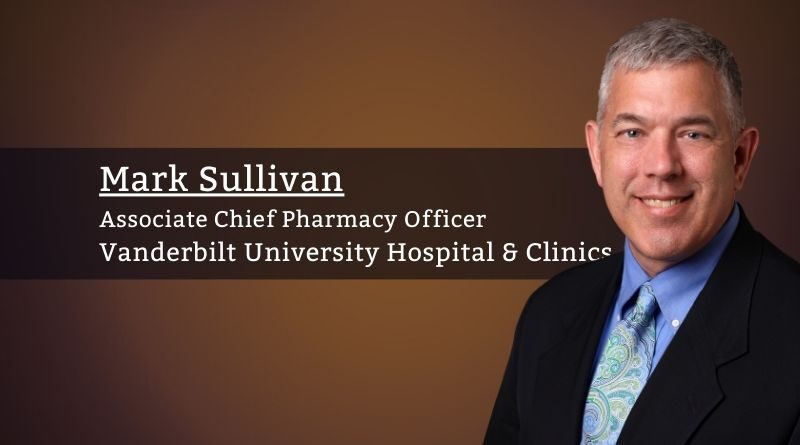Perspective on Medication Management Technology: An Imperative for Advancement
By Mark Sullivan, Associate Chief Pharmacy Officer, Vanderbilt University Hospital & Clinics
Today’s health system pharmacy leaders face a myriad of challenges related to using technology in pharmacy practice. Strategic planning for capital support for larger systems has become a part of long-term financial planning as lead times for capital acquisition to support technology replacement on a ten to fifteen-year life cycle is required to maintain effective systems.
Electronic healthcare record (EHR) vendors are advancing in their support of pharmacy, but key areas such as sterile products compounding, pharmacokinetic dosing of medications to support personalized therapies, and lack of linkages between contracted payor reimbursement requirements and continued modifications of payment tactics between medical and pharmacy benefit in the ambulatory space offer areas for third party vendors to fill these gaps.
Human resources to manage these systems may or may not be located within the oversight of the health system pharmacy leader. Many organizations have created health informatics departments to support build for systems, but project management for large system implementations may need to be resourced, managed by the pharmacy operations team, or managed by the vendor. These scenarios create opportunities for governance as mergers and acquisitions occur to maintain standardization between EHRs, disparate pharmacy storage and dispensing systems, and various third-party vendor systems being used. Standardization efforts remain a focus as staff may need to rotate between facilities and efficiencies gained by having systems implemented in a standard fashion supports safe use and staff satisfaction. Other systems such as smart pumps may be purchased by Supply Chain leadership, maintained by Clinical Engineering, used by Nurses and Anesthesia, and have drug files maintained by Pharmacy or Health IT staff. These type of scenarios require multidisciplinary governance oversight to support change to drug libraries and maintain technology currency.
For health system pharmacy leaders who are supported by other departments from a systems perspective, maintenance of effective working relationships with health informatics departments, clinical engineering departments, nursing, anesthesia, respiratory therapy and other professions engaged in the medication management process are key to day to day as well as strategic planning for maintenance of these systems. Challenges in larger systems arise when lack of alignment in medication management-related initiatives arises. One part of the system may be advocating for expansion of bar code medication administration into ambulatory areas due to fatigue with manual documentation of vaccines during the pandemic, while the pharmacy may be advocating for implementation of image capture/gravimetrics to advance safety in sterile products operations, while others in the system focused on personalized medicine may be advocating for implementation of third-party vendors to support optimization of pharmacokinetics software. Division of focus may result in extended or inefficient implementation processes and when multiple vendors are introducing new products that require additional modification for optimization, getting systems to optimal operation may appear to be a never-ending process.
A new development for pharmacy leaders is the introduction of various interest groups to drive improvements in the healthcare automation space.
A new development for pharmacy leaders is the introduction of various interest groups to drive improvements in the healthcare automation space. Standardization of basic systems continues to be a need in the industry. Multiple platforms that do not interface in this age of health systems technology need to be mitigated. For example, this scenario currently exists in the RFID space. The UnitVis Alliance has been formed to advocate for industry standards in the RFID space to advance the use of this technology for tracking doses dispensed, managing inventory of high-cost medications, tracking temperature and humidity for medication storage and sterile products preparation areas and tracking equipment within health systems such as pumps, wheelchairs, beds and other durable medical equipment.
Another example in this space is the Autonomous Pharmacy concept being advocated by a cabinet vendor to address existing gaps in systems that require manual manipulation that result in inefficient systems and increased error. This group has published severalpeer-reviewed articles to support this advocacy and has launched a survey tool to help systems evaluate objectively where they are on the journey to fully automated systems. Expansion of efforts such as these to engage other vendors is complicated by concerns over competitive issues in the industry, but accomplishment of these long-term visions of fully automated systems with ISO 9000 levels of accuracy will require engagement across the industry to be successful.
Another approach in this space are institution-led grassroots efforts. Colleagues in Houston have recently launched the Boots and Roots Rx collaborative to bring together pharmacists, analytics, compliance specialists, project managers, health informaticists, and others to problem solve in this space.
While these efforts are laudable to advance technology and practice, focusing on pharmacy informatics education and developing next generation of experts in this space remains a challenge for the health system pharmacy leader. Pharmacy informatics residency programs struggle to place residents and develop future practitioners in this space. Vendors have recently realized the dearth of training opportunities in this space and have funded fellowship programs to expose recent college graduates to various aspects of pharmacy informatics and industry-based informatics, along with graduate-level education in this space to support future iterations of leaps in pharmacy technology.
After thirty to forty years of EHR /cabinet/carousel/IV robotics/smart pump/, data visualization and analytics, health system pharmacy leaders must advocate for their systems with vendors and industry standard-setting organizations to vision the next generation of systems that fully interface throughout the medication use system from patient assessment to medication intervention via prescribing, through dispensing, to administration, and monitoring followed by assessment of contracting and reimbursement to support sustainable revenue cycles that support patient adherence and meet desired clinical treatment goals to improve patient quality of life must enter the broader conversation in this space. Without this focus, we are bound to continue limited improvement in these systems and will miss the opportunity for “moon shot” level initiatives that yield the technological advancements we need for our patients.



